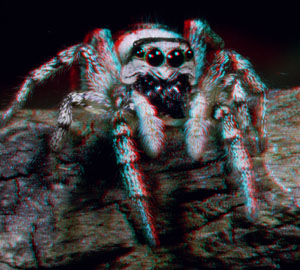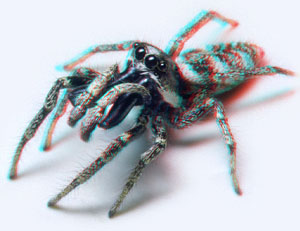THE ZEBRA-SPIDER in 3D
by Wim van Egmond
the Netherlands
|

Click image to view
large version. Use red and blue 3D glasses!
|
| One
of the commonest spiders you can find around the house is
the zebra spider, Salticus scenicus. You can find
it sitting on the wall or on a window-frame but it is not
so easy to spot. It is a tiny spider with a body size
that doesn't exceed 8 millimetres, but you can use a hand
lens to its spectacular appearance. The zebra spider
belongs to the jumping spiders. It does not make a web
but stalks its prey. It will use a silk thread as an
anchor. When it spots an insect it will slowly try to
approach it. Now and then when it is out of the victim's
sight the zebra spider will run. When it is within reach
it will jump and paralyse the prey with its venomous
'jaws'. |
| To be able to
capture prey like this jumping spiders rely on superb eye
sight. Their eyes are truly remarkable. The front pair is
the most impressive. They can be regarded as the best
eyes you can find in any arthropod. They work as a
telephoto lens. The retina inside the eye can move in 3
dimensions enabling the spider to look in all directions
and focus on a subject. When you approach a jumping
spider it will position itself so it can observe you. The
6 other eyes are positioned around the head for a 360
degrees vision. |

Click image to view
large version. Use red and blue 3D glasses!
|
A male zebra spider (left) is hiding
its huge chelicerae ('jaws') behind its pedipalps (the
little boxing gloves'). The males use the large chelicera
for battles. The pedipalps (often called just 'palps')
are secondary sexual organs. The spider deposits its
sperm on a small web and then uses a special reservoir
within the pedipalp to carry its seed around. It will
then try to mate with a female zebra spider. Mating is
often a dangerous procedure. The male spider uses its
front legs to make all kinds of signals to avoid being
mistaken for a prey. It has to try to reach the
reproductive organ of the female, called the 'epygine',
which is situated under the abdomen. When the sperm is
transferred the female will carry it in a special
compartment and will use it when she is ready to
fertilise her eggs.
Since jumping
spiders rely so much on their sight they can easily be
fooled by using a mirror. The male will try to attack its
own reflection.
|
The images were taken from living
spiders. These pictures will be part of a CD ROM with 3D images
of insects spiders and other small creatures. This CD ROM will be
available later this year!
Comments to the
author Wim van Egmond are welcomed.
Many more 3D images
can be found via Wim's HOME PAGE
Microscopy UK Front Page
Micscape Magazine
Article Library
Copyright
all material: Wim van Egmond
Please
report any Web problems or offer general comments to the Micscape Editor,
via the contact on current Micscape Index.
Micscape is
the on-line monthly magazine of the Microscopy UK web
site at Microscopy-UK
WIDTH=1
© Onview.net Ltd, Microscopy-UK, and all contributors 1995 onwards. All rights
reserved. Main site is at www.microscopy-uk.org.uk with full mirror at www.microscopy-uk.net.
